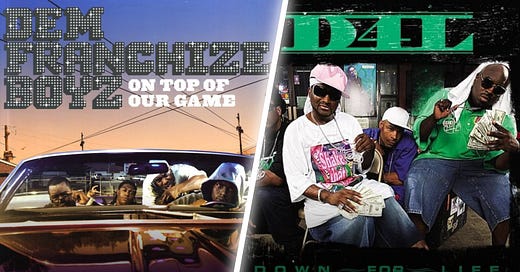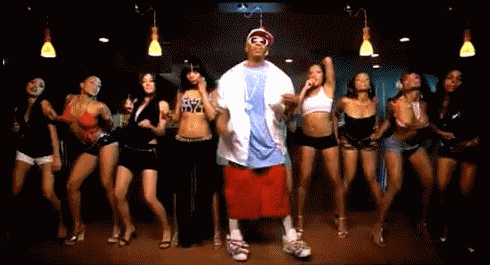The early 2000s were an interesting time in music.
New York dominated the airwaves with the likes of Murder Inc., Fat Joe, 50 Cent, and G-Unit.
While all of this was happening, a sound coming from the Westide of Atlanta started bubbling on the underground. That sound would eventually change the course of music and set much of the stage for what we see today.
Today, we know it and the movement it started as:
SNAP MUSIC.
When Snap Music hit the scene, the music industry started to feel the effects of Napster and P2P platforms, which were eating into its revenue and causing a decline in CD sales.
At the same time, music production & recording software was becoming more accessible to the average person. Because young creators now had the means to record their own songs and dances, an entire sub-genre (the first of many) of Hip-hop was born.
While the Snap era only lasted roughly 3 years, its effects can still be seen today in Hip-hop and even through apps like TikTok, where remnants of its impact still live.
But, first things first…
What Exactly Was Snap Music?
In a nutshell, Snap is dance music, more or less.
One could say that the Snap era was bound to happen because of Atlanta’s DNA. Dances have always been at the heart of ATL culture, dating back to the days of Yeeking and The Bankhead Bounce.
In that way, Snap is essentially the child of the ‘90s Atlanta sound.
In fact, one of the stars of this era (who we’ll get to in a sec), was signed by a producer who helped stamp Atlanta’s sound: Mr. Collipark — who many know as DJ Smurf, a driving force behind ATL Bass music.
But for we talk about that, we gotta ask ourselves…
How Did It Get Popular?
Aight, so let’s take it back to 2005.
Two Atlanta groups are widely considered the pioneers of the sound and dance that kicked off this era. Both were four-member groups from Bankhead in Atlanta and are legends in their own right.
Those groups were:
Dem Franchize Boyz & D4L.
There’s a bit of controversy as to which group originated the sound. Still, if we’re going purely based on timestamps and interviews with some of the key figures in this movement, the story goes like this…
Dem Franchize Boyz was already bubbling underground in Atlanta, with songs like "Money” and “White Tee” making their way across the city.
In August 2005, everything changed when they released “Oh I Think They Like Me,” which is widely credited as one of the first songs to popularize the snap sound.
“Oh I think They Like Me” eventually became so popular that Jermaine Dupri, whom we talked about in the Bass Music era a few weeks back, hopped on the remix along with Da Brat and Bow Wow.
The remix would go on to be a defining song from the Snap era, but it doesn’t stop there.
Dem Franchize Boyz had three songs from this period that forever stamped them in Atlanta. We talked about the first two, but there was also “Lean Wit It, Rock Wit It.”
Lean Wit It, Rock Wit It was another Snap-era gem that solidified the dance accompanying the music and became a national hit. But that was in ‘06. Let’s back up a bit…
Just a month or so after Dem Franchize Boyz dropped “Oh I Think They Like Me,” D4L also dropped a record that forever changed conversations around Hip-hop culture.
It was a fun dance record that created a ton of controversy about the state of rap music. It also marked the decline of New York in favor of a new contender: Atlanta.
As for the record itself? It was called “Laffy Taffy.”
Laffy Taffy became D4L’s breakthrough record and was partially responsible for bringing Snap to a national audience (in combination with Dem Franchize Boyz record “Lean Wit It Rock Wit It).
D4L followed up the release of Laffy Taffy with their debut album “Down For Life” and another Snap-era favorite, “Betcha Can’t Do It Like Me.”
Shortly after the release of the D4L album, Shawty Lo was also formally introduced to the world as a solo artist. In that same time period, he brought a new sound to Atlanta with “Dey Know”—it isn’t technically a “Snap” record, but it’s a defining song for Atlanta culture.
SNAP BECAME THE SOUND OF 2006
According to Parlae of Dem Franchize Boyz, it wasn’t even called “Snap music”—the records were purely music made for the club. More specifically, they were made for Pool Palace, a popular club on ATL’s Westside in the early 2000s.
But with the success of Dem Franchize Boyz and D4L, record labels went all in on the sound, giving it the moniker “Snap.”
Fabo showed himself to be a star in this era with his high-energy presence and dance skills, which he leveraged on quite a few records, and Atlanta continued to pump out hits at record levels.
DJ Unk, another ATL native from Oomp Camp, one of Atlanta’s most historic record labels, also made his national debut this year with a pair of songs that became some of the biggest in the snap era: Walk It Out & Two Step.
These records had us in a chokehold back in 7th grade. I’m tryna tell ya…
And here are just a few other records from that era that still elicit feelings from Millennials everywhere:
And an underground gem or two…
This one’s the Bunny Hop (another personal favorite)
IT PEAKED IN 2007
‘07 was lowkey Snap Music's biggest year. This is when all the prior forces mentioned combined into a singular moment that changed music forever.
So, remember Mr. Collipark?
In 2007, he signed a new rapper widely considered the first to break through on the Internet. You might know him as Soulja Boy Tell ‘Em.
Soulja Boy’s breakthrough song “Crank That’ gained popularity from the filesharing boom we mentioned earlier, making its way to the youth who were now downloading all their music online.
And it wasn’t just the sound that made “Crank That” a hit, but also the dance that came with it.
After “Crank That” hit the scene, many budding musicians saw the internet as a route into the music industry and used his formula to succeed.
From there, you saw a lot of local ATL groups popping up who made their own “crank that” dances and similar steps.
A personal favorite of mine is “Crank Dat Yank” by Camp22:
Ringtone Rap & The Rise of ATL
With the rise of Soulja Boy, the ringtone industry also came.
Labelheads searching for a way to make money ended up signing a slew of one-hit wonders, which, combined with the rise of cell phones, gave birth to ringtone rap. Going platinum was such a myth in those days that artists used ringtone sales to measure success—wild times.
Moreover, Hip-hop fans were discouraged by the direction that they saw the culture going, especially when Laffy Taffy became a hit record. To them, it symbolized a decline in lyricism and quality and a new low in raunchiness (if only they knew what was coming in the next decade, smh).
Hip-hop purists would say that the South killed Hip-hop, and Nas even dropped an album around this time entitled “Hip-hop Is Dead—" one of his best albums, in my opinion.
But, despite how critics felt about Snap Music, it didn’t kill rap music. Instead, the Snap Era marks the start of Atlanta’s cultural dominance. These years were when other regions started copying the Atlanta sound and style.
EPILOGUE
In hindsight, Snap Music wasn't as bad as it was made out to be. At the time, Atlanta and the associated artists caught a bad rap for ruining Hip-hop. Still, this sound actually helped the industry advance at a time when it was about to collapse.
Above that, let's admit it was really fun music overall.
Gangsta rap had a chokehold in the '90s and early 2000s. The South reminded people to have fun with it again (and then NY copied us, but that's another story for another day).
I've been running the hits back for old time's sake.
Life can be serious, especially these days, so if you've got a sec, check out some of the jams from this era. It's Friday, after all. You gotta have some fun with it.





Another great Snobhop edition, the new generation needs to know more about the snap effect, crunk and other good ATL moments that defined the construction of today's trap.